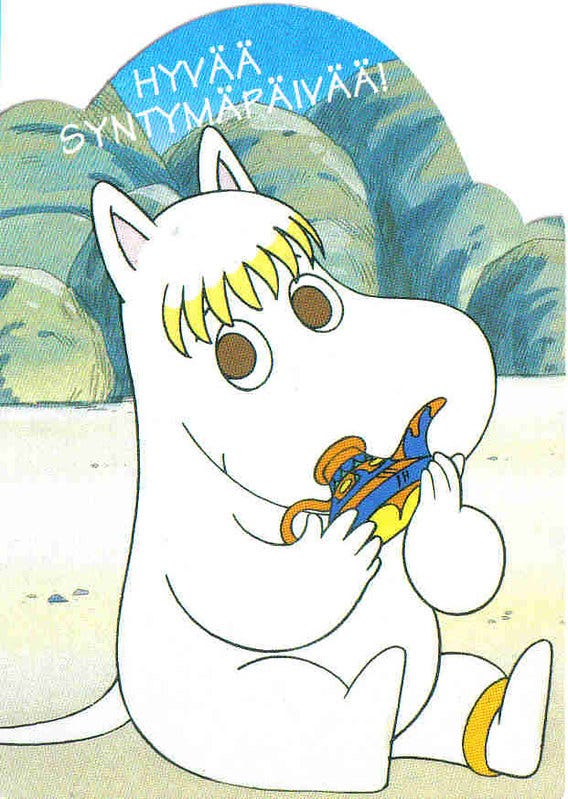Welcome to A Narrative of their Own, where I discuss the work of 20th century women writers and their relevance to contemporary culture.
I’ve seen a lot of book recommendations going around these past couple of weeks for the best ‘summer reads’. I think a lot of people (including myself) associate the holiday season with relaxing in the sun and getting more reading done.
While watching a book club series the other evening featuring some translated literature, I was reminded of Tove Jansson’s The Summer Book, which was originally published in 1972. I read this book a few summers ago, and had forgotten how wonderful it was. Returning to it, I realised it was a summer book with a difference, and worth exploring further.
Tove Jansson was a Finnish artist who was most well known for creating the Moomins characters who originally appeared in a series of novels, short stories, and a comic strip between the years 1945 and 1993. These later went on to appear in several TV series, films and two theme parks, not to mention a whole truckload of merchandise featuring the characters which is still popular today.
Jansson, who created both the illustrations and the stories for the Moomins, apparently wanted to make a creature that was round and soft. Though they resemble the hippopotamus, they are in fact a family of trolls living in Moominvalley and having adventures with their friends.
Although I had heard of Jansson when the Moomin books and TV series were popular as a child, I came to her other novels as an adult, and was surprised to find them atmospheric, thought-provoking and often very funny.
Jansson’s work was very much influenced by nature and the outdoors. In fact, in 1964, and at the age of 50, Jansson moved to a home on what she considered her dream island. Klovharun in the Finnish archipelago is a tiny isolated 6,000 square metre island where despite having no running water or electricity, Jansson and her partner, artist Tuulikki Pietilä, spent the long summers, arriving in April as soon as the ice broke and leaving in early October, loving the privacy and remoteness of the island.
Despite being more commonly recognised for her family of trolls, Jansson was a painter, novelist, short story writer and at one time anti-Nazi cartoonist and magazine cover designer.
Born in Finland and speaking Swedish Jansson is seen as quite a pioneer in her approach to both life and art. Living on both land and water, enjoying relationships with both male and female lovers, and creating books through both prose and art, both her writing and her illustrations are rooted in nature and landscapes. Even in her Moomin books there are visions of landscapes that appear to predict climate change. Jansson and Pietilä’s time on their Finnish island was hard and rough, with the fog and extreme, stormy weather and the firewood to collect, the fish to gut. But it seemed that they liked it that way.
These landscapes and hardy connections with nature are reflected in her books, as well as her paintings. The Summer Book is almost a love song to nature, as well as the idea of tolerance.
“[Jansson’s novels are] a masterpiece of microcosm, a perfection of the small, quiet read”.
The novel tells the story of a grandmother and her granddaughter exploring a small Finnish island over one summer. As Ali Smith pointed out in the above article, the story is never sentimental; instead, Jansson uses the inter-generational relationship between the pair to highlight the importance of respect, both for each other and the nature of the island. The book is respectful and open-minded, much as Jansson herself was.
The inspiration for the granddaughter in the novel was the author’s niece Sophia Jansson, who says she had always accepted as normal her family of adventurers, exploring uninhabited islands every summer. Sophia’s mother died when she was just six years old, and she references her “core family” as being made up of her father, grandmother, aunt Tove and Tove’s partner Tuulikki.
The book is also humorous, as Jansson gently pokes fun at the ideas other people might have around ‘normality’. For example, when the granddaughter has a friend over to stay from the mainland, she finds her boring in her quiet and fearful ways.
It could be said that for both the characters in The Summer Book and for Jansson herself, the island allowed for freedom to live as both an artist and within her own sexuality. As the real-life Sophia points out, homosexuality was still classified as an ‘illness’ within Finland at the time, and though as a young girl there was never an actual name given to the couple’s relationship, it was understood by all the family that they loved one another, and were accepted for it.
“You can believe what you like, but you must learn to be tolerant.”
The Summer Book
I came to Tove’s writing and The Summer Book several years ago without expectations, liking the look of the picture of the island on the cover and in the middle of a summer spent reading books and memoirs situated in the natural world. What I found was a book with a lot of heart. At its core is a meditation on the care we need to take of the world we inhabit: of both the preservation of the natural world around us and of the people we encounter within it, however different.
Jansson’s beautiful, often funny writing lets us know that every plant, creature and person has a right to exist and to be taken care of.
If that isn’t the perfect kind of ‘summer read’ for this present moment, I can’t think of a better one!








One of our very favourite books – and loved your thoughts on the way the island functions as a space of respect!